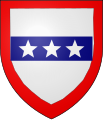Moir ([MOY-er]) is a surname of Scottish origin, and is part of the Clan Gordon of the Scottish Lowlands. The name in its present form dates from the 14th century and means "brave, renowned, mighty" in Scots Gaelic. Four generations of Moirs were active members of the Burgesses & Guild Brethren of Glasgow, 1751-1846.
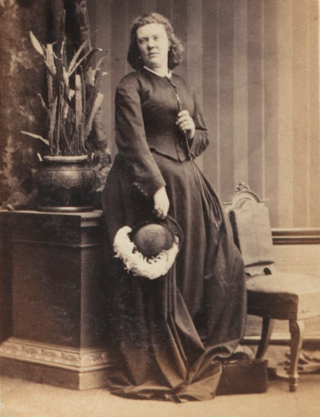
Edith Maud Rawdon-Hastings, 10th Countess of Loudoun was a Scottish peer. She died aged 40 after caring for Rowallan Castle. Sir George Gilbert Scott designed an Eleanor Cross style monument to her which was erected in Ashby de la Zouch.

Clan Hunter is a Scottish clan.
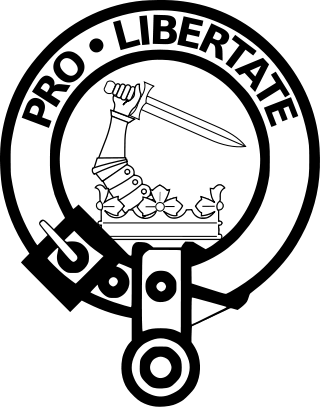
The Clan Wallace is a Lowlands Scottish Clan and is officially recognized as such by the Lord Lyon King of Arms. The most famous member of the clan was the Scottish patriot William Wallace of the late 13th and early 14th centuries.

Clan Arthur or Clan MacArthur, is a highland Scottish clan that once held lands on the shores of Loch Awe opposite Inishail. The clan has been described as one of the oldest clans in Argyll. Clan Arthur and Clan Campbell share a common origin, and at one point the MacArthurs challenged the seniority of the leading Campbell family. A branch of MacArthurs from the Isle of Skye were a sept of the MacDonalds of Sleat, and were hereditary pipers for the MacDonalds of the Isles. In late 18th century the chief of the clan died without an heir, leaving the clan leaderless until the late 20th century. In 2002, the first chief of Clan Arthur was recognised in about 230 years.

Clan MacAulay, also spelt Macaulay or Macauley is a Scottish clan. The clan was historically centred on the lands of Ardincaple, which are today consumed by the little village of Rhu and burgh of Helensburgh in Argyll and Bute. The MacAulays of Ardincaple were located mainly in the traditional county of Dunbartonshire, which straddles the "Highland Line" between the Scottish Highlands and Lowlands. Clan MacAulay has been considered a "Highland clan" by writers and has been linked by various historians to the original Earls of Lennox and in later times to Clan Gregor. The MacAulays of Ardincaple, like Clan Gregor and several other clans, have traditionally been considered one of the seven clans which make up Siol Alpin. This group of clans were said to have claimed descent from Cináed mac Ailpín, King of the Picts, from whom later kings of Scotland traced their descent. The chiefs of Clan MacAulay were styled Laird of Ardincaple.

Rowallan Castle is an ancient castle located in Scotland. The castle stands on the banks of the Carmel Water, which may at one time have run much closer to the low eminence upon which the original castle stood, justifying the old name Craig of Rowallan. Elizabeth Mure was mistress and then wife of Robert, High Steward of Scotland, and Guardian of Scotland, who later became King Robert II of Scotland. She may have been born at Rowallan.
Elizabeth Mure, a member of Clan Muir, was the first wife of Robert, High Steward of Scotland, and Guardian of Scotland, who later became King Robert II of Scotland.

Clan Crawford is a Scottish clan of the Scottish Lowlands. The clan is of Scandinavian and Anglo-Saxon origin. There was in the early 18th century a mistaken belief that the clan had Norman origins. While historically recognised as a clan by the Court of the Lord Lyon, it is now an armigerous clan as it no longer has a chief. The last chief was Hugh Ronald George Craufurd, who sold his land and moved to Canada in 1904. He died in Calgary in 1942, leaving no male heirs.
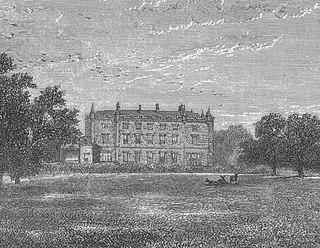
Caldwell is a mansion and old estate with the remains of a castle nearby. These lands lie close to the Lugton Water and the villages of Uplawmoor in East Renfrewshire and Lugton in East Ayrshire.

Kennox House is situated on Kilwinning Road between Stewarton to Torranyard in North Ayrshire, Parish of Dunlop, Scotland. The house overlooks the Glazert Burn, which runs into the Annick Water at Watermeetings.

James Mure-Campbell, 5th Earl of Loudoun was a Scottish aristocrat, soldier and MP.
Sir William Mure of Rowallan (1594–1657) was a Scottish writer and politician.

William Mure, known as others of his family as William Mure of Caldwell, was a Scottish lawyer and politician. He became a Baron of the Scots Exchequer and was a friend of Prime Minister Lord Bute and David Hume.
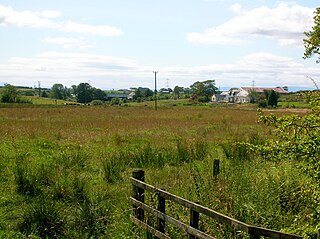
Polkelly Castle, also Pokelly, was an ancient castle located near Fenwick, at NS 4568 4524, in the medieval free Barony of Polkelly, lying north of Kilmarnock, Parish of Fenwick, East Ayrshire, Scotland. The castle is recorded as Powkelly (c1747), Pockelly (c1775), Pow-Kaillie, Ponekell, Polnekel, Pollockelly, Pollockellie, Pokellie, Pothelly, Pathelly Ha' and Polkelly. The name is given circa 1564 as Powkellie when it was held by the Cunninghams of Cunninghamhead.

The remains of the old castle of Montfode or Monfode lie to the north-west of the town of Ardrossan and 1.5 miles (2.4 km) south-west of West Kilbride in North Ayrshire, Scotland, above the Montfode Braes, in the old Barony of Kilbride. The remains of the 16th century tower are protected as a scheduled monument. The castle ruins are clearly visible from the A78 Ardrossan bypass.
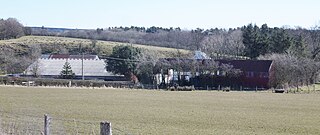
Dalmusternock (NS455417) was a dower house built and occupied by William Mure after his marriage and prior to inheriting the family seat of Rowallan Castle. The property is located near Fenwick, in the Barony of Rowallan, lying 3 miles north of Kilmarnock and 18 miles south of Glasgow, Parish of Fenwick, East Ayrshire, Scotland. The estate is recorded as Dalmunsternoch circa 1654; Dalmasternock circa 1747; Dalmusterknok 1775
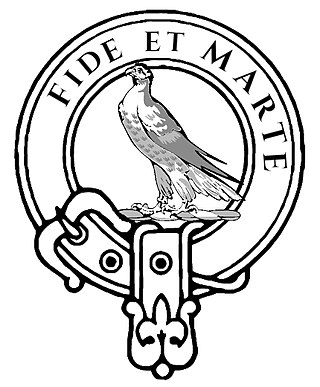
Clan Ralston is a Scottish clan. The clan is recognized as such by the Court of the Lord Lyon, but as it does not currently have a chief recognized by the Lord Lyon King of Arms it is considered an Armigerous clan.

Minishant is a village bordering the A77 in the old county of Carrick, South Ayrshire, Scotland. It is located in Maybole Parish, 3+1⁄2 miles from Maybole and standing close to the River Doon. The village was originally named Culroy after the Culroy Burn that runs through it.
SirRobert Mure or Muir was a Scottish landowner, imprisoned by James VI for intimidating his tenants.








